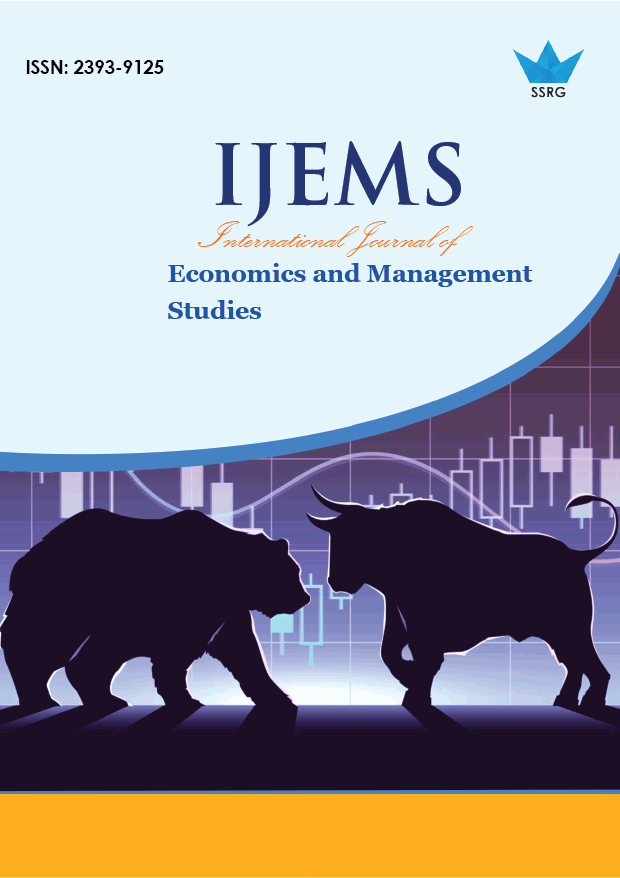The Impact of Debt Overhang on Economic Growth: A Study of India and its Neighbouring Countries

| International Journal of Economics and Management Studies |
| © 2025 by SSRG - IJEMS Journal |
| Volume 12 Issue 6 |
| Year of Publication : 2025 |
| Authors : Ritvik Singhal |
How to Cite?
Ritvik Singhal, "The Impact of Debt Overhang on Economic Growth: A Study of India and its Neighbouring Countries," SSRG International Journal of Economics and Management Studies, vol. 12, no. 6, pp. 32-38, 2025. Crossref, https://doi.org/10.14445/23939125/IJEMS-V12I6P103
Abstract:
Around the world, particularly in developing economies, debt has become a crucial factor influencing economic stability and growth. As global debt levels reach unprecedented highs, understanding its impact on economic performance has never been more essential. This study aims to analyze how debt accumulation has influenced economic stability and growth in India and its neighbouring economies. This study explores key macroeconomic indicators, debt structures, and fiscal sustainability to assess whether excessive debt overhang hinders economic progress. The study utilizes a fixed-effects regression model on a panel dataset comprising India's neigbouring countries—namely China, Bangladesh, Pakistan, Sri Lanka, Nepal, Bhutan, and Afghanistan—spanning the years 2008 and 2022. Key predictor variables include debt overhang, revenue adequacy, exchange rates, and reserves adequacy, while GDP growth serves as the response variable. The results indicate that both debt overhang and exchange rate volatility have a significantly negative effect on GDP growth. Conversely, revenue adequacy and reserve levels showed no meaningful influence on economic performance. These outcomes emphasize the importance of sound debt governance and maintaining exchange rate stability to support economic stability and resilience. This study underscores the necessity for policymakers to implement sustainable debt strategies and prudent fiscal policies. Strengthening economic fundamentals and ensuring responsible borrowing practices are crucial for mitigating risks associated with excessive debt burdens in the region.
Keywords:
Debt Overhang, Debt Management, Economic Growth, Fiscal Sustainability, South Asia.
References:
[1] Fiscal Affairs Department, International Monetary Fund, Global Debt Monitor 2024, 2024. [Online]. Available: https://www.imf.org/external/datamapper/GDD/2024%20Global%20Debt%20Monitor.pdf
[2] Jorgelina do Rosario, Global Public Debt Hits Record $92 Trillion – UN Report, 2023. [Online]. Available:https://y94.com/2023/07/12/global-public-debt-hits-record-92-trillion-un-report/
[3] A World of Debt 2024, UN Trade and Development (UNCTAD), 2024. [Online]. Available:https://unctad.org/publication/world-of-debt
[4] Michael Pettis, How Does Excessive Debt Hurt An Economy?, Carnegie Endowment for International Peace, 2022. https://carnegieendowment.org/china-financial-markets/2022/02/how-does-excessive-debt-hurt-an-economy?lang=en
[5] J. McBride, Greece’s Debt Crisis Timeline, Council on Foreign Relations, 2022. [Online]. Available: https://www.cfr.org/timeline/greeces-debt-crisis-timeline?utm_source=chatgpt.com
[6] Daniel Liberto, European Sovereign Debt Crisis: Eurozone Crisis Causes, Impacts, Investopedia, 2024. https://www.investopedia.com/terms/e/european-sovereign-debt-crisis.asp?utm_source=chatgpt.com
[7] Reserve Bank of India. [Online]. Available: https://rbi.org.in/home.aspx
[8] Carmen M. Reinhart, and Kenneth S. Rogoff, “Growth in a Time of Debt,” American Economic Review, vol. 100, no. 2, pp. 573-578, 2010.
[CrossRef] [Google Scholar] [Publisher Link]
[9] Stephen G. Cecchetti, Madhusudan S. Mohanty, and Fabrizio Zampolli, “The Real Effects of Debt,” SSRN, pp. 1-39, 2011.
[Google Scholar] [Publisher Link]
[10] Sami AL Kharusi, and Mbah Stella Ada, “External Debt and Economic Growth,” Journal of Economic Integration, vol. 33, no. 1, pp. 1141-1157, 2018.
[Publisher Link]
[11] Pham Thi Phuong Thao, “Impacts of Public Debt on Economic Growth in Six ASEAN Countries,” Ritsumeikan Annual Review of International Studies, pp. 63-88, 2018.
[Google Scholar] [Publisher Link]
[12] Paul Ndubuisi, “Analysis of the Impact of External Debt on Economic Growth in an Emerging Economy: Evidence from Nigeria,” African Research Review, vol. 11, no. 4, pp. 156-173, 2017.
[CrossRef] [Google Scholar] [Publisher Link]
[13] M. Ayhan Kose et al., “What has been the Impact of COVID-19 on Debt? Turning a Wave into a Tsunami,” SSRN, pp. 1-36, 2021.
[CrossRef] [Google Scholar] [Publisher Link]
[14] Amy Gallo, “A Refresher on Regression Analysis,” Harvard Business Review, 2015.
[Google Scholar] [Publisher Link]
[15] I. Scott MacKenzie, “Modeling Interaction,” Human Computer Interaction, pp. 233-292, 2013.
[CrossRef] [Publisher Link]
[16] C.C. Ragin, “Case-Oriented Research,” International Encyclopedia of the Social & Behavioral Sciences, pp. 1519-1525, 2001.
[CrossRef] [Publisher Link]
[17] Adam Hayes, Multicollinearity: Meaning, Examples, and FAQs, Investopedia, 2024. [Online]. Available: https://www.investopedia.com/terms/m/multicollinearity.asp
[18] Caroline Banton, Serial Correlation: Definition, How to Determine, and Analysis, Investopedia, 2021. [Online]. Available: https://www.investopedia.com/terms/s/serial-correlation.asp#:~:text=Serial%20correlation%20is%20used%20in,is%20independent%20of%20one%20another
[19] Tilburg Science Hub, Testing for Serial Correlation, Tilburg Science Hub. [Online]. Available: https://tilburgsciencehub.com/topics/analyze/tests/tests-assumptions/serial-correlation/#:~:text=Wooldridge%20test,the%20lagged%20residuals%20equals%20%2D0.5
[20] Corporate Finance Institute, Heteroskedasticity, Corporate Finance Institute, 2024. https://corporatefinanceinstitute.com/resources/data-science/heteroskedasticity/
[21] A. Colin Cameron, and Pravin K. Trivedi, Microeconometrics Using Stata, Stata Press, 2022. [Google Scholar] [Publisher Link]
[22] The Economic Ripples of Rising Government Debt, SA-TIED. [Online]. Available: https://sa-tied.wider.unu.edu/article/the-economic-ripples-of-rising-government-debt
[23] Briteweb, The National Debt Can Crowd Out Investments in the Economy — Here’s How, Peterson Foundation, 2024. [Online]. Available: https://www.pgpf.org/article/the-national-debt-can-crowd-out-investments-in-the-economy-heres-how/
[24] The Fiscal and Financial Risks of a High-Debt, Slow-Growth World, IMF, 2024. [Online]. Available:https://www.imf.org/en/Blogs/Articles/2024/03/28/the-fiscal-and-financial-risks-of-a-high-debt-slow-growth-world
[25] How High Economic Uncertainty May Threaten Global Financial Stability, IMF, 2024. [Online]. Available: https://www.imf.org/en/Blogs/Articles/2024/10/15/how-high-economic-uncertainty-may-threaten-global-financial-stability
[26] Justin Joy, and Prasant Kumar Panda, “Pattern of Public Debt and Debt Overhang among BRICS Nations: An Empirical Analysis,” Journal of Financial Economic Policy, vol. 12, no. 3, pp. 345-363, 2019.
[CrossRef] [Google Scholar] [Publisher Link]
[27] Kingsley Onyekachi Onyele, and Emmanuel Chijioke Nwadike, “Impact of National Debt Burden on Economic Stability in Nigeria,” Economics and Business, vol. 35, no. 1, pp. 91-106, 2021.
[CrossRef] [Google Scholar] [Publisher Link]
[28] Assessing Reserve Adequacy - Further Considerations, IMF, 2013. [Online]. Available: https://www.imf.org/en/Publications/Policy-Papers/Issues/2016/12/31/Assessing-Reserve-Adequacy-Further-Considerations-PP4843?utm_source=chatgpt.com

 10.14445/23939125/IJEMS-V12I6P103
10.14445/23939125/IJEMS-V12I6P103